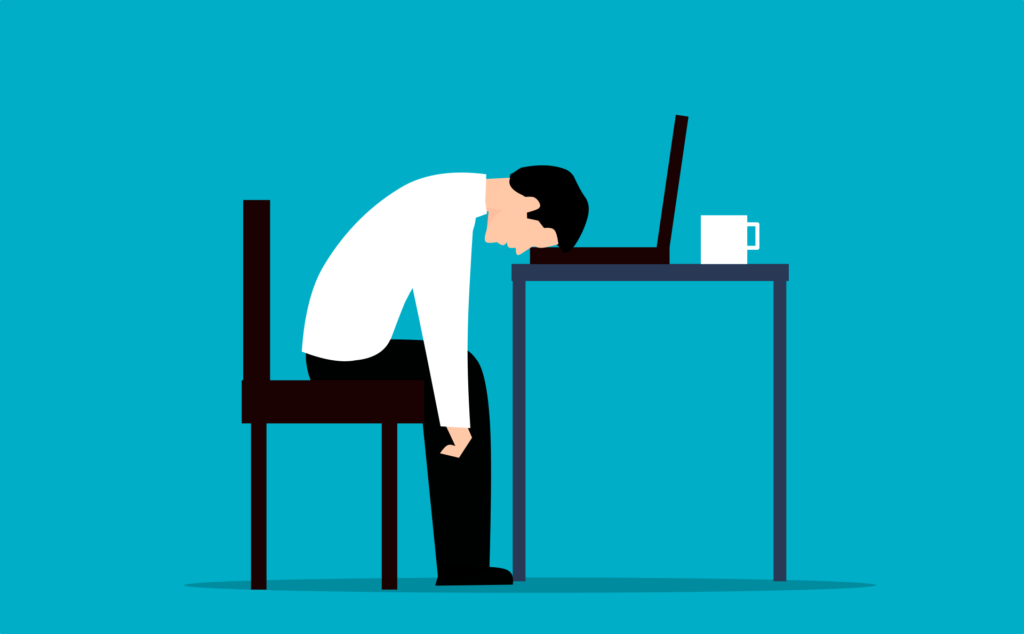What Is Internet Addiction?
It’s of paramount importance to discuss common things about internet addiction. The Internet is one of the most astonishing inventions of the twentieth century. It has changed the way we interact and also the way we process information. It also opened a whole new world of socializing, entertaining, and disseminating information that was never accessible to us before. The problem is that all of this comes with an attendant cost. The more time we spend on the Internet, the more dependent we get. Many people get stuck in a cycle of addiction where they want to use the web more, but feel like they need to use it less.

Internet addiction is defined as a pathological pattern of internet use, which is also described as internet dependence, compulsive internet use, problematic internet use, internet abuse, and pathological internet use[1]. The user cannot self-control the use of the internet, resulting in significant impairment at school, home, work, health, or interpersonal relationship[2]. They may find it difficult to stop using the internet due to its anonymity, convenience, and accessibility and may use it as a way to escape reality [3].
It is quite common and easy to get lost on the internet. A simple activity like checking Twitter or chatting online can turn into a full-blown addiction where users get lost in TikTok or other portals. Often to the detriment of their work and social life. Here we will look at how internet addiction can affect you and what you can do to stay safe online.
Sub Types Of Internet Addiction
The following are the different subtypes of internet addiction according to Dr. Kimberly Young:
- Cyber-Sexual addiction (a compulsive need to access virtual sex and pornographic websites)
- Cyber-relation addiction (excessive involvement in relations arising in the network)
- Net-compulsion (compulsive behaviors related to online activities such as gambling, shopping, and e-trade)
- Information overload (an obsessive search for news on the web)
- Computer addiction (which include internet gaming disorder)
Is Internet Addiction A Mental Disorder?
It is not yet officially recognized as a mental disorder. Diagnostic criteria for internet addiction have been formulated, but it is not included in the diagnostic and statistical manual of mental disorders (DSM-5) and international classification of disease (ICD 10/ICD 11). However, internet gaming disorder has been included in DSM-5.
Common Signs/Symptoms Of Internet Addiction

Internet addiction is a serious problem that has been gaining attention in the past decades. With the advent of all the new technologies at our disposal, we are spending more time on the Internet. Although the internet is a useful tool, there are some signs that your internet use is beginning to take over your life. Here is a list of common signs/symptoms of internet addiction:
- Behavior that continues despite negative consequences
- Loss of control by the time connected to the internet
- Increasing time spent on the internet
- Loneliness
- Feeling distressed when away from the internet (irritability, physical aches, palpitation)
- Preoccupied with internet and digital media outlet
- Deterioration of social relationships
- Negative impact on academic and work-life
- Not being able to control how much time you are spending online
- Sudden change in mood
- Boredom with routine tasks
- Poor personal hygiene
- Dry eyes and other visual problems
- Poor nutrition (eat junk food for failure to avoid being away from the internet)
- Headaches
- Backache
- Poor sleep
- procrastination
Risk Factors For Internet Addiction
As Internet Use Disorder has gained credibility, more studies focused on risk factors associated with the development of the disorder. The risk factors can loosely be classified as social factors, psychological factors, and biological factors;
Social Factors

The following are some of the social factors:
- Loneliness as a risk factor is consistent with the findings that suggest social relationships are key component in the development of internet addiction. The more addictive apps are chat rooms, interactive games, instant messaging or social media, suggesting that the condition is socially driven.
- A more discrete social risk factor for the internet addiction is the development of online affairs. An online affair is a romantic or sexual relationship initiated via online contact and maintained predominantly through email, chat rooms or online communities.
- Interpersonal challenges (e.g., introversion, social issues, poor face-to-face communication skills) were identified as having a major role in the development of problematic Internet use.
- Lack of social connection and social support is a potential risk factor as individuals turn to virtual relationships as a substitute for the missing social connection in their lives.
- Other factors include poor self-esteem, feeling isolated, solitude.
Psychological Factors
The following are some of the psychological factors:
- History of dependence (e.g., alcohol, opioid dependence) and psychiatric disorders affect Internet dependence.
- The most common co-morbidity with internet use disorder disorder is major depression and attention deficit hyperactivity disorder (ADHD)[4]
Biological Factors
The following are some of the biological factors:
- EEG studies were conducted and it showed that those subjects classified as Internet addicts had lower brain scan activation on a game playing procedure than the normal group.
- The Internet addiction disorder subjects showed less efficiency in information.
- It has been shown that excessive Internet users have a higher prevalence of SS-genotypes, higher harm avoidance, and depression scores, suggesting that excessive users may have genetic and personality traits similar to depressed patients.
What Are The Effects Of Internet Addiction?

Internet addiction has numerous negative consequences that are too numerous to mention, below are some of the effects:
- Body aches
- Carpal tunnel syndrome
- Poor sleep
- Visual problems
- Weight gain/loss
- Depression/Feeling Sadness
- Dishonesty
- Anxiety
- Social isolation
- Aggression
- Mood swings
- Increased risk for substance abuse
- Time disruption with subsequent interference with regular social life, including academic, professional performance, and daily routines
Is There A Test Or An Assessment I Can Do?
The best method to clinically detect compulsive use of the internet is to compare it against criteria for other established addictions.
Internet Addiction Diagnostic Questionnaire
The internet addiction diagnostic questionnaire (IADQ) was the first screening instrument developed by Dr. Kimberly Young [5] it has the following 8 criteria:
- the person is preoccupied with the internet
- there is a need to spend more and more time on the internet to achieve satisfaction
- unsuccessful attempts to control, reduce, or interrupt the use of the internet
- feels anxiety and depression in reducing or stopping the use of the internet
- remains on the internet much longer than it is intended
- endangers personal contacts, job, study, career
- conceals the truth about addiction from family members and helping professionals;
- uses the internet to escape the problem
Answers evaluated non-essential Internet usage such as for non-business or academic-related use. Subjects were considered ‘dependent’ when they have 5 or more of the above six months not associated with manic or hypomanic episodes.
Internet Addiction Test
The most commonly used questionnaire for the measurement of internet addiction called the Internet Addiction Test (IAT) was developed by Dr. Kimberly Young in 1998. IAT is a 20-item scale that measures the presence and severity of internet addiction [6]. This test was designed as a research and diagnostic tool, based on the DSM-IV criterion for pathological gambling diagnosis. The IAT is a symptom-measuring tool for internet addiction.
The test measures the degree of involvement in online activities using responses on the 5-degree Likert type scale and categorizes the addictive behavior into four categories: lack of addiction, mild signs of addiction, moderate signs of addiction, and severe addictive behavior. The test score range from 20-100, a higher value indicates problematic internet use.
- 20-39=average internet user
- 40-69=potentially problematic internet user
- 70-100=problematic internet user
Other instruments include:
- The Problematic Internet Use Questionnaire (PIUQ)
- The Compulsive Internet Use Scale (CIUS)
- Internet consequences scale (ICONS)
How To Avoid Falling Into An Internet Addiction Trap?
Internet addiction is better prevented than treated which is better explained by the adage “prevention is better than cure”. The following are some of the tips:
- Set a timer on your phone and computer to limit the duration spent on the internet
- If you are type that always pick his/her phone to go online on every notification, make it a rule to only use these social media apps on a computer
- Create a healthy hobby/activity to replace internet usage in leisure time, e.g. engaging in a sport, talking a relative
- Create a distraction for yourself to postpone internet use
- Engage with your family, community
Treatment Of Internet Addiction
If you are concerned that you or someone under your care have an internet use disorder, kindly contact your family doctor or visit any nearby addiction treatment center.
The following are some of the treatment options;
- The individual, group, or family therapy
- Cognitive behavior therapy
- Motivational interviewing
Anonymous support group: search for an internet use disorder support group to find either physical or virtual meetings, nearby you, much like alcohol anonymous or narcotics anonymous.
The group will help you walk through your behavior while keeping you accountable along the path of recovery.
Conclusion
People can suffer from an internet addiction disorder in the same way that they can suffer from other addictions, such as alcohol or drug dependence. The symptoms can be very similar. People who suffer from internet addiction may experience cravings and withdrawal symptoms when they are unable to use the web, and they may spend excessive amounts of time on the web, neglecting their duties and responsibilities. What do you think you need to do to reduce/prevent the risk of having an internet addiction disorder?
For more articles, visit psycheducate
Resources
- Widyanto L, Griffiths M. “Internet addiction”: a critical review. Internat J Ment Health Addict. 2006; 4:31–51
- Young KS. Internet addiction: a new clinical phenomenon and its consequences. Am Behav Sci. 2004;48:402–15
- Kardefelt-Winther D. A conceptual and methodological critique of internet https://www.sciencedirect.com/science/article/pii/S0747563213004093addiction research: toward a model of compensatory internet use. Comput Human Behav. 2014; 31:351–4.
- Gundogar A, Bakim B, Ozer OA, Karamustafalioglu O. The association between internet addiction, depression and ADHD among high school students. Eur Psychiatry. 2012; 27:1
- Young KS. Caught in the net: how to recognize the signs of internet addiction-and a winning strategy for recovery. New York: John Wiley & Sons, Inc.; 1998.
- Young KS, de Abreu CN, editors. Internet addiction: a handbook and guide to evaluation and treatment. New York: John Wiley & Sons, Inc.; 2010




